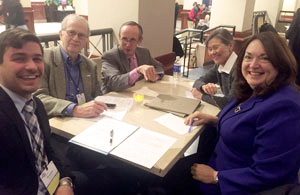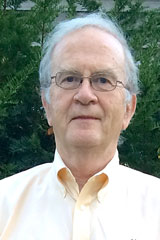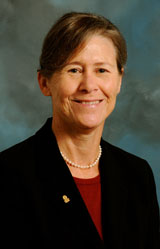Mar 31, 2015
What Is the One Thing from the History of Rural Health That We Should Not Forget?
by Brandon Baumbach, RHIhub's Rural Health Policy
Specialist

As someone still relatively new to rural health, I'm excited to moderate a panel of the rural health leaders interviewed below at the National Rural Health Association Annual Conference in Philadelphia. The session is titled "Rural Health's Legacy: Transferring Knowledge Between Generations" and will discuss how current leaders can prepare the next generation of rural health leaders by passing on history, lessons learned, experience, information, and passion. As a preview of the session, we've asked each of the panelists to weigh in on the question:
"What is the one thing from the history of rural health that we should not forget?"
I hope many of our readers can join us at the April 16th session. If you would like to submit questions for the panelists in advance, please email me at brandon@ruralhealthinfo.org.
 Tom Morris, HRSA Associate
Administrator
Tom Morris, HRSA Associate
Administrator
Federal
Office of Rural Health Policy
One universal lesson from rural health policy is that the past usually repeats itself. Time and again, we see sometimes well-intentioned policies and approaches to healthcare that are designed for larger population areas that don't work as well in lower population areas. Rural communities then spend years sorting through those challenges. We've seen it in health finance where payment systems based on volume had significant effects on the viability of rural hospitals. We've also seen it in public health where incentives in both large discretionary and block grants tend to focus the funding more on broad population health improvement on a particular metric, such as obesity, which favors funding projects in larger urban areas rather than in areas of the greatest need. What's needed is a process that takes rural considerations into account on the front end rather than the back end.
 Kristine Sande, Program Director
Kristine Sande, Program Director
Rural Health Information Hub
We have to be vigilant and creative to protect healthcare access for rural citizens. Throughout the history of rural health, there has been change, some of which has been quite painful for rural healthcare providers and the people they serve. Unintended consequences of health policy changes have created real problems for rural healthcare over the years. One positive consequence from the tumultuous 1980s was the establishment of a rural health infrastructure at the national and state level. The Federal Office of Rural Health Policy, the National Advisory Committee on Rural Health and Human Services, State Offices of Rural Health, Rural Health Research Centers, membership organizations like the National Rural Health Association, and other key organizations all work to help ensure rural concerns are heard. We need to remember why this infrastructure exists and be vigilant in ensuring each of these organizations have the necessary "on the ground" information to look out for the needs of rural citizens.
Creativity helps us deal with the ever-changing healthcare environment. We have some rural models of care that have worked well for rural America, but we have to assume that the models we have now for providing services in rural America are not the 'final models'. We can refine them or develop new models that will work for rural communities as circumstances, such as demographics or healthcare policy, change. We know from experience that models of care absolutely need to be informed by those most familiar with the rural environment.
 Tim Size, Executive Director
Tim Size, Executive Director
Rural Wisconsin Health
Cooperative
The Critical Access Hospital program became a reality with the Balanced Budget Act (BBA) of 1997 – the result of one and a half decades of coordinated work across the country. My favorite act of advocacy was in 1988 when we at the National Rural Health Association filed a class-action suit against the Department of Health and Human Services. Our constitutional claim was the "unjust taking of property" due to Medicare's failure to provide just compensation to rural hospitals for services to Medicare patients. We knew the case was unlikely to succeed in the courts, and it didn't. But the consequent attention brought by the legal arguments helped to galvanize supporters to the cause.
 Teryl Eisinger, Executive
Director
Teryl Eisinger, Executive
Director
National Organization of
State Offices of Rural Health
We cannot forget the importance of partnerships – purposeful partnerships that include responsibilities and accountability as well as the opportunity to share and benefit from successes. It's very easy to say we partner with this organization or that coalition, but in the end if there isn't debate and uncertainty and risk, it probably wasn't much of a true partnership. Partners who do the hard work together also have the satisfaction of sharing that success and the rewards that come with it. It takes time and probably even a step backward or two, but it's worth the work to make good things happen.
 Janice Probst, Director
Janice Probst, Director
South Carolina Rural Health Research Center
The biggest thing to learn from the history of rural health is that the struggle is a marathon, not a sprint (or a hammer throw). As a wide-eyed college student, I was convinced that my generation would conquer everything: racism, health disparities, poverty, all of it. The world was going to get better. Rural health? We had discovered the problems of poor rural health in recruiting offices in World War II, when supposedly healthy country boys (mostly boys back then) were found unfit for service at higher rates than urban recruits. Programs were implemented to help ensure that rural communities had needed health services: the Hill-Burton program for rural hospitals in 1946, followed by the programs of the 1960's (National Health Service Corps, federally qualified health centers) and the 1970's (rural health clinic funding). Surely the trajectory was upward!
But, stretching the metaphor, none of those hammer throws have provided a permanent and lasting solution to rural health disparities. Programs once put in place have to be continually monitored for appropriate implementation and continually defended from attack as the prominence of "rural America" fades from our collective psyche. [Remember the Waltons & Little House on the Prairie? Rural is no longer big on mainstream TV.] The social determinants of health in some parts of the U.S. continue to be characterized by racial or economic disparities reinforced by local power structures. While enormous progress has been made at promoting social justice, this too is a marathon effort.
Is the view that maintaining rural equity requires "a marathon rather than a sprint" a depressing vision? Not necessarily — it just means you have to have a different pattern of training, practice and expectation. We have to expect to work for rural over a very long term.
